Real-Time Monitoring of Surface Effects on the Oxygen Reduction Reaction Mechanism for Aprotic Na−O2 Batteries
Jing Zhang1, 3, Xia-Guang Zhang2, Jin-Chao Dong3, Petar M. Radjenovic3, David James Young4, Jian-Lin Yao 1,*(姚建林), Ya-Xian Yuan1,*(袁亚仙),Zhong-Qun Tian3, and Jian-Feng Li3,*(李剑锋)
1College of Chemistry, Chemical Engineering and Materials Science, Soochow University, Suzhou 215123,China
2Key Laboratory of Green Chemical Media and Reactions, Ministry of Education, Collaborative Innovation Center of Henan Province for Green Manufacturing of Fine Chemicals, College of Chemistry and Chemical Engineering, Henan Normal University, Xinxiang 453007, China
3State Key Laboratory of Physical Chemistry of Solid Surfaces, College of Chemistry and Chemical Engineering, College of Energy, iChEM, Xiamen University,Xiamen 361005, China
4College of Engineering, Information Technology and Environment, Charles Darwin University, Casuarina, Northern Territory 0909, Australia
J. Am. Chem. Soc. 2021, 143, 20049--20054
Discharging of aprotic sodium–oxygen (Na–O2) batteries is driven by the cathodic oxygen reduction reaction in the presence of sodium cations (Na+-ORR). However, the mechanism of aprotic Na+-ORR remains ambiguous and is system dependent. In-situ electrochemical Raman spectroscopy has been employed to study the aprotic Na+-ORR processes at three atomically ordered Au(hkl) single-crystal surfaces for the first time, and the structure–intermediates/mechanism relationship has been identified at a molecular level. Direct spectroscopic evidence of superoxide on Au(110) and peroxide on Au(100) and Au(111) as intermediates/products has been obtained. Combining these experimental results with theoretical simulation has revealed that the surface effect of Au(hkl) electrodes on aprotic Na+-ORR activity is mainly caused by the different adsorption of Na+ and O2. This work enhances our understanding of aprotic Na+-ORR on Au(hkl) surfaces and provides further guidance for the design of improved Na–O2 batteries.

链接://pubs.acs.org/doi/abs/10.1021/jacs.1c10009